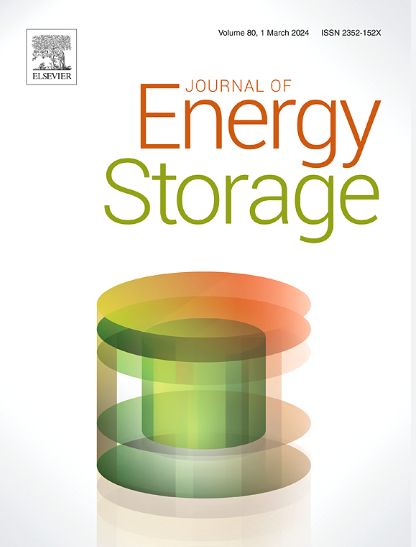Theoretical Contribution to multiphysical modeling of flywheel energy storage systems with a focus on thermal effects in magnetic bearings
IF 8.9
2区 工程技术
Q1 ENERGY & FUELS
引用次数: 0
Abstract
This paper gives a theoretical contribution to the multiphysical modeling of Flywheel Energy Storage Systems. In this work, a laboratory prototype of a flywheel consisting of a vertical rotor supported by one axial passive magnetic bearing and by two radial active magnetic bearings, is used as an example for modeling. The rotor is modeled as a flexible body accounting for thermal and centrifugal expansions. The forces from the passive magnetic bearing are evaluated using experimentally validated analytical expressions based on Lorentz’s law, while the forces from the active magnetic bearings are calculated using the virtual work principle. The current dynamics are obtained through Ohm’s, Faraday’s, and Ampere’s laws. The temperatures are found from the energy equation, in which the heat sources are the system’s energy losses due to eddy currents and ohmic effects. The outcome of the multiphysical model is a set of nonlinear equations depending on the states: (i) the rotor lateral and axial displacements and velocities, (ii) the currents of active magnetic bearing stators, and (iii) the temperatures in the rotor and bearing stator. The system of equations is linearized around the operational point allowing for the calculation of a state matrix as a function of rotor and active magnetic bearing stator temperature, material, and geometrical properties of the rotor, passive magnetic bearing, and active magnetic bearings. The coupled linearized system is solved together such that it highlights the thermal effects on the natural frequencies, damping ratios, and time constants of the system. This holistic approach can be useful when optimizing and designing model-based controllers for flywheels.
对飞轮储能系统多物理模型的理论贡献,重点是磁轴承的热效应
本文为飞轮储能系统的多物理建模提供了理论依据。在这项工作中,以一个由一个轴向被动磁轴承和两个径向主动磁轴承支撑的垂直转子组成的飞轮的实验室原型为例进行建模。转子被建模为考虑热膨胀和离心膨胀的柔性体。被动磁轴承的受力采用基于洛伦兹定律的实验验证解析表达式进行计算,主动磁轴承的受力采用虚功原理进行计算。电流动力学是通过欧姆定律、法拉第定律和安培定律得到的。温度由能量方程求出,其中热源是由于涡流和欧姆效应引起的系统能量损失。多物理模型的结果是一组依赖于状态的非线性方程:(i)转子横向和轴向位移和速度,(ii)主动磁轴承定子的电流,以及(iii)转子和轴承定子的温度。方程组在工作点周围线性化,允许计算状态矩阵作为转子和主动磁轴承定子温度,材料和转子,被动磁轴承和主动磁轴承的几何特性的函数。耦合线性化系统一起求解,这样就突出了热效应对系统的固有频率、阻尼比和时间常数的影响。这种整体方法在优化和设计基于模型的飞轮控制器时非常有用。
本文章由计算机程序翻译,如有差异,请以英文原文为准。
求助全文
约1分钟内获得全文
求助全文
来源期刊

Journal of energy storage
Energy-Renewable Energy, Sustainability and the Environment
CiteScore
11.80
自引率
24.50%
发文量
2262
审稿时长
69 days
期刊介绍:
Journal of energy storage focusses on all aspects of energy storage, in particular systems integration, electric grid integration, modelling and analysis, novel energy storage technologies, sizing and management strategies, business models for operation of storage systems and energy storage developments worldwide.
 求助内容:
求助内容: 应助结果提醒方式:
应助结果提醒方式:


